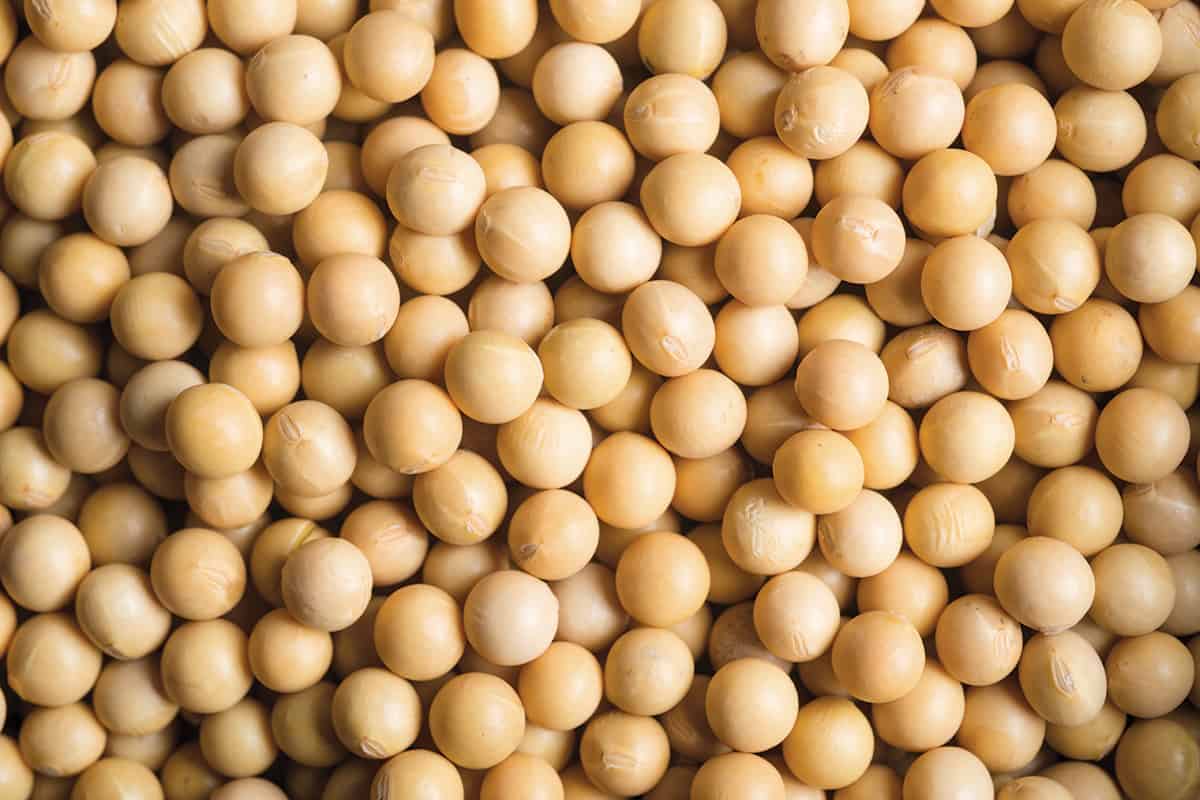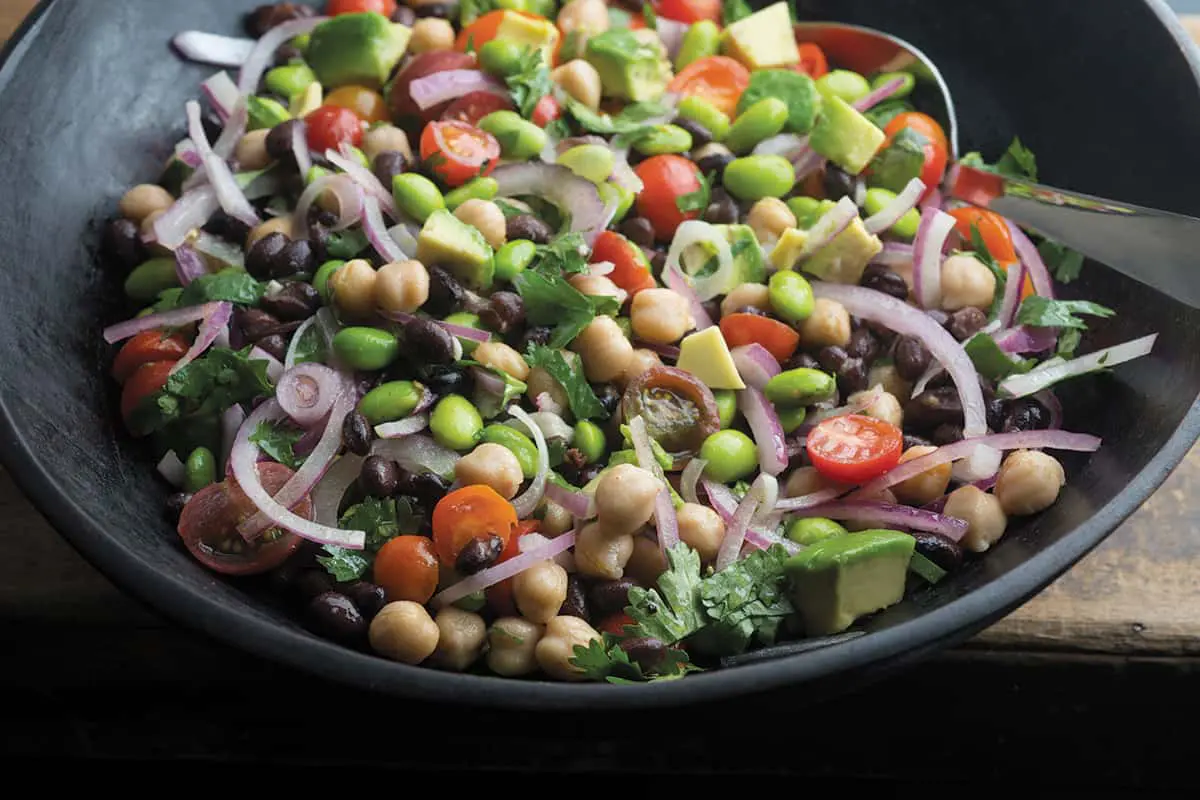Story by Kate Hull Photographs by Paulette Phlipot
–
From tofu to veggie burgers, edamame to vegan milk and cheese, as a substitute for meat, or an ingredient situated in a long list of not-so-recognizable items, soy seems to pop up just about everywhere. Proponents swear by it, while adversaries say leave it in the dust. This protein-packed food, derived from the soybean plant, conjures up a love-hate debate that’s gaining real steam, or at least fogging the window.
The soy dispute is loaded and chock-full of dos and don’ts. Can we eat too much? Are we eating enough? So, let’s dive in.
The Bean
Soy is a legume widely grown throughout the Midwest. Each flowering plant contains pods with pea-sized beans. Once harvested, the tiny protein-packed beans can then be used for anything from biodiesel fuel and crayons, to animal feed and protein supplements.
In the grocery aisles, soy can be found in its whole form or as a filler ingredient used in many processed products. In its whole form, the bean is commonly consumed as edamame—immature green soy beans, usually in the pod—or fermented to make miso, tofu, or tempeh, a product originating in Asia and predominantly used in the West by vegetarians to replace meat. A soy protein isolate is the extracted form of soy used to boost protein levels or enhance texture in everyday foods, like breads, cereals, and salad dressings. “Soy protein isolates can be found in items like bars, shakes, and pills. The soy proteins are taken out of the bean or re-created in a laboratory to make supplements that claim certain benefits,” says Mary Howley Ryan, a registered dietitian and the founder of Beyond Broccoli Nutrition Counseling and Education, based in Jackson, Wyoming.
For Howley Ryan, the conversation begins with the type of soy: whole versus processed or genetically modified. “If we are talking about whole food—dry soybeans that you soak and cook or edamame—I have zero problem with that,” she says. “But the majority of soybeans grown in our country [to make ingredients for processed food and animal feed] are genetically modified [GMO]. I am not comfortable with that.” Howley Ryan recommends, as with all foods, to enjoy soy in moderation and pay attention to organic and non-GMO certified labels. “I don’t think it is a superfood, although I do think that whole or minimally processed soy can be very beneficial for vegan diets,” she says. “I would much rather people eat food than food products.”
The Science
Over the past five years, scientific studies have added fuel to the soy-debate fire, showing conflicting research that the phytoestrogens found in soy—a naturally occurring source of estrogen similar to what’s found in our bodies—might be harmful to women’s bodies, either delaying menstrual cycles or even linking excesses to higher breast cancer risks. Still, others see it as an estrogen-blocking mechanism.
Because soy contains a plant-based estrogen that is the closest naturally occurring form to our own, questions are raised about what this does to our cells.
(Need a quick biology refresher? Me, too.)
Our body’s cells have estrogen receptor sites that are made of proteins and activated by the hormone to communicate growth. The receptor sites work like a sewing needle, taking thread in and out of a piece of fabric and leaving messages inside the cell as it goes. Once the receptor site receives its message, the cell changes and adapts.
“The cell begins to change its basic structural sequence if it is continually bombarded by signals from high amounts of estrogen,” says Kevin Meehan, a Jackson-based biochemist and nutritionist, and the founder of Meehan Formulations. “High amounts of estrogen can begin to influence that cell, and, in many cases, in a negative fashion. That is why you see it attributed to cancers and things like that.”
But Meehan says this is not the case with soy. He explains that the phytoestrogens contained in soy mimic your body’s own estrogen intake and block the receptor sites, stopping additional estrogen from being metabolized into the cell. “If you have receptor sites or pores that are occupied or satisfied, there is no need for the additional estrogen,” he says. “The estrogen can’t respond to these pores, so it ends up in the circulatory system and is metabolized to become fuel.
“Many people believe soy is bad because it increases estrogen. But it increases estrogen in the circulatory value only because it blocks the receptor sites,” he says. With this concept in mind, Meehan has developed soy-containing supplements as a way to combat certain imbalances in his patients, from premenopausal symptoms to hyperthyroidism. “In premenopausal situations, there is a fluctuation of the hormones. Soy can be effective at balancing that receptor site and can be used efficiently to stabilize the way a woman goes into menopause,” he says.
A 2014 study published by Oxford University Press found that adding soy supplements to women’s diets led to an increase in the expression of genes that are linked with cancer growth in a small group of women. Still, Meehan looks to centuries of low instances of cancer in Asian women, whose diets relied heavily on soy in its purest form—whole or fermented—to support his claims.
Research from the Shanghai Women’s Health Study (conducted on 75,000 Chinese women) in 2014 found that timing and consumption levels are everything when it comes to soy. Women who consumed high amounts of soy protein throughout adolescence and early adulthood had nearly a 60 percent lower risk of premenopausal breast cancer than women with low consumption. “We have the best trials in front of us, and that is history.
Let’s follow those trials,” Meehan says. “Look at centuries of indigenous societies that have lived a specific way, and look at their health record.”
The studies and claims are constant, so for those without time to spend researching the data, Howley Ryan turns to meta-analysis, a scientific overview of multiple studies that looks for trends, inconsistencies, or conclusions. The Huazhong University of Science and Technology in Wuhan, China, analyzed thirty-five studies on soy isoflavones intake and breast cancer risk. The findings? Soy consumption could lower breast cancer risks in pre- and postmenopausal women in Asian countries. But in Western countries, those effects are marginal and fairly neutral. “[These findings] are more positive to me than negative. In Asia, they eat a lot of soy. If it was a toxin, we wouldn’t have millions eating it on a daily basis,” Howley Ryan says. “But at the same time, we can’t assume the data we see in Asian countries will apply to every ethnic group.” She encourages her clients to look at research with a critical eye and explore other opinions. And she considers the large amount of genetically modified soy in the United States to play a role in the less positive results as compared with Asia.
From the Farm to the Aisles
Dale Sharkey, farm manager at Victor’s Cosmic Apple Gardens and a mother of three, only feeds her family whole or fermented soy. “We are big proponents of unprocessed and non-GMO food. The only soy my family eats is naturally fermented soy sauce, tempeh, and edamame,” she says. Her reasoning? The high percentage of genetically modified soy that is available.
According to 2014 statistics from the Department of Agriculture, over 90 percent of the soy grown in the United States is genetically modified. So, if you’re having a hard time locating organic soy, critics say to blame it on big industry. Federal subsidies back big farms with a goal of producing mass amounts of soy, most of which is genetically modified. It’s sold to feed cows that we use for burgers, or dairy cows whose milk shows up in our refrigerators, or it’s converted into biofuels.
Unfortunately, you won’t find certified-organic soy in your local Community Supported Agriculture share just yet (but you can find it at Jackson Whole Grocer, Lucky’s Market, and Barrels & Bins). Sharkey says the temperamental crop doesn’t thrive in the unpredictable Teton Valley weather; it’s mainly grown in Midwestern states like Iowa and Illinois.
The great soy debate has sprouted many branches. For some, like Sharkey and Howley Ryan, soy spawned from genetically modified crops is not so great. For Meehan, soy, when used correctly, can effectively halt imbalances. But one thing all three can agree on—soy is best in its whole form. Read food labels, make educated decisions, eat in moderation, and, when in doubt, ask experts like Howley Ryan or Meehan. “If you are concerned about GMOs, buy organic. But you can also eat a whole-food diet without buying organic,” Sharkey says. “Start making your own salad dressings [to avoid oils processed from GMO soybeans]. Make things from scratch and you eliminate the worry.”
Edamame Salad with a Southwestern Kick
—
Serves 6
—
Perfect as a side, a protein-packed lunch, or a simple entree.
Just make sure to grab certified-organic shelled edamame
for this wholesome, tangy meal.
—
1 package frozen organic edamame
1 cup canned organic garbanzo beans, drained and rinsed
1 cup canned organic black beans or pinto beans,
drained and rinsed
1/2 red onion, thinly sliced
1 cup cherry tomatoes, halved
1/2 cup cilantro, chopped
1 clove garlic, minced
Juice from half a lemon
1/4 cup extra virgin olive oil
1/2 tablespoon Dijon mustard
Salt and pepper
1 avocado, diced
1. Prepare the edamame based on package directions.
2. Combine all veggies in a medium bowl.
3. Mix the lemon juice, olive oil, mustard, and salt and pepper in a small glass bowl. Pour over vegetables and toss with thawed edamame.
4. Top with avocado and salt and pepper to taste. Enjoy right away or cool in refrigerator.
* Recipe adapted from yummyhealthyeasy.com



